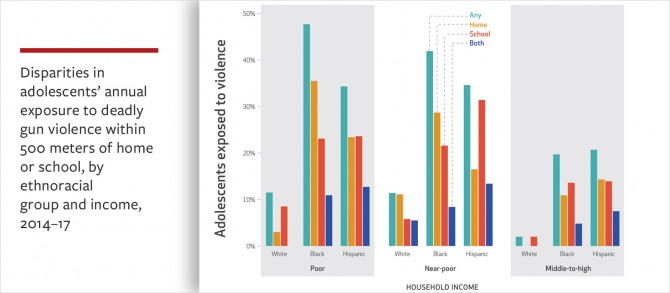
Sarah James, the Frank H. T. Rhodes postdoctoral fellow in the Cornell Population Center
News directly from Cornell's colleges and centers
Adolescents exposed to gun violence – new study finds sharp, ethnoracial and income disparities
By Sheri Hall
Gun violence is pervasive in the lives of adolescents who were born in U.S. cities, and it affects poor and minority adolescents at higher rates than higher income or white adolescents.
That’s the conclusion of a study co-authored by Sarah James, the Frank H. T. Rhodes postdoctoral fellow in the Cornell Population Center and published this month in the journal Health Affairs.
To determine the prevalence of gun violence near adolescents’ homes and schools, the researchers used national data on deadly gun violence incidents from the Gun Violence Archive, a nonprofit group that gathers information from more than 7,500 law enforcement, media, government and commercial sources, combined with data from the Fragile Families and Child Wellbeing Study, a study of 5,000 children born from 1998 to 2000 in large U.S. cities.
“Our original idea was to understand how violence matters for child development,” James said. “We decided to focus on gun violence because firearms are used in three-quarters of homicides in the United States and we know that exposure to violent events affects health and behavior going forward. It’s not something that abates after a day or two.”
When combining the data, the research team looked for instances of deadly gun violence within 500 meters – about one-third of a mile or a 6-minute walk – of adolescents’ homes and schools over the course of a year, when the teens were about 15 years old. (They excluded suicides from their analysis.)
Overall, they found that 21 percent of adolescents lived or attended school within 500 meters of a deadly gun violence incident in that year. They also found that this exposure varied by racial and ethnic group and household income. Fewer than five percent of white adolescents were exposed to deadly gun violence compared to about a quarter of Hispanic adolescents and about a third of Black adolescents. About one-third of poor or near-poor adolescents were exposed to deadly gun violence, versus ten percent of middle-to-high income adolescents.
While James said she expected variations in adolescents’ exposure to deadly gun violence, she was shocked by the sharp disparities, especially when combining race, ethnicity and income. Close to half of poor black adolescents and one third of poor Hispanic adolescents were exposed to deadly gun violence, compared to two percent of middle-to-high income white adolescents.
“We find that the disadvantages compound,” she said. “What was really striking to me is that even black and Hispanic adolescents in the most well-off households had more exposure than white families living in the poorest households.” About one in five middle-to-high income Black and Hispanic adolescents were exposed to deadly gun violence, versus about one in ten poor white adolescents.
The researchers also found that for white and Hispanic adolescents, a larger share of their exposure to deadly gun violence was near their schools, while Black adolescents were more likely to be exposed to gun violence near their homes.
“These findings are similar to prior research on residential segregation, which shows that ethnoracial group is associated with the types of neighborhoods where people live because of the history of housing discrimination in this country,” James said. “Understanding how schools and other spaces in which adolescents spend their time complicate this story is certainly something to pursue in the future.”
This study is among the first to use data from the Gun Violence Archive, James said. Comparing that data to information on deaths caused by firearms collected by the U.S. Centers for Disease Control and Prevention shows a strong correlation, she said, with the Gun Violence Archive capturing 88 percent of such deaths.
“Because the Gun Violence Archive is gathering information from a variety of sources, they are doing a great job of capturing the vast majority of deadly gun violence in the United States,” she said.
That’s exciting because the Gun Violence Archive provides what James calls “hyperlocal” data. “We used to analyze data like this on a county level, which doesn’t tell us much about the experiences of individuals,” she said.
Other authors of the paper are Sarah Gold, a postdoctoral research associate at Princeton University; Shiva Rouhani, a graduate student at the University of California Los Angeles; Sara McLanahan, professor of sociology and public affairs at Princeton University, and Jeanne Brooks-Gunn, a professor of child development at Columbia University.
Media Contact
Get Cornell news delivered right to your inbox.
Subscribe